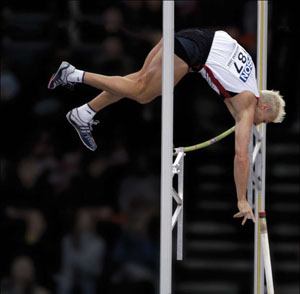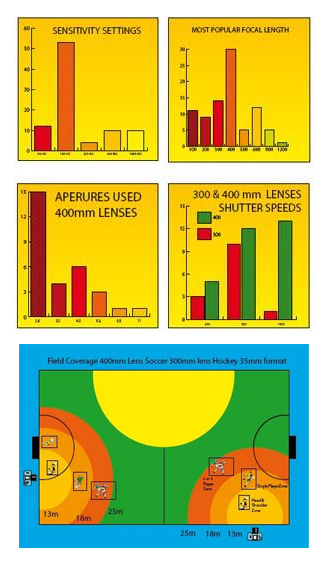articles/Sports/sportingchance-page1
Sporting Chance - part 1 of 1 2 3 4 5 6 7
by Mike McNamee Published 01/09/2006

McNamee goes back to his roots and tries to remember what it was it was like sitting by a pitch on a cold foggy November day!
Sports photography is the macho end of the profession, all about action, timing, thrills and spills. It is also intensely competitive as the number of slots for photographers is often severely limited by space or commercial restrictions. The technology has also changed as rapidly (or more rapidly) than many other branches of photography.
The two major changes are the ability to run longer w i t h o u t changing " f i l m " and the transmission of images by radio, directly to the picture desk. With the t e c h n o l o g y comes expense, and certainly a lot more kit to lug along to a venue, with mobile phones, laptops and radio systems. An indirect effect of not having to transport film across the film gate is that it is easier to speed up a camera and framing rates have risen with relatively inexpensive cameras such as the Nikon D200 pushing 5fps whilst its D2X cousin can chug along at 8fps.
Some things, however, do not change. Fast hands and good eyes are still as important as ever, as is knowledge of the sport you are photographing. ISO speeds have stayed relatively constant with 100 ISO still preferred - the only difference is that you can change the rating on digital "mid-film". A desire to stay at 100 ISO demands f2.8 lenses, as we will demonstrate later in this feature, but one supreme advantage for the sports photographer is that the smaller digital chip gives additional focal length at little or no extra cost - what is the bane of the architectural photographer is a boon to his sports colleague!

The Exposure Value
This is simple deduction. In average UK sunlight you need 1/ISO as your shutter speed with f11 as your aperture. For an ISO of 100 and an aperture of f2.8 you are able to use a shutter speed of 1/2000ths.
The Database
An analysis of the lenses used and camera settings was conducted by the author some years ago (on film cameras, not digital). The images were all made by the All Sport photographers and mainly award-winning pictures. We reproduce some of the data in graphical form. In a nutshell it shows that the most common lens used is 400mm focal length, at f2.8 and with shutter speeds of 1/1000ths. Shooting at these magnifications and these shutter speeds requires a steady hand, smooth movement (if following action) and an ability to follow-focus.
The question of whether to use autofocus or manual used to find in favour of manual and that was certainly employed 10 years ago. Today's autofocus is so good that the options are closer and you can use either, especially using autofocus to lock-on and then blipping the focus lock just at the correct moment.
Why 400mm?
The costs of Nikon, Canon, Sigma and Tamron long lenses are tabled opposite. None of them is inexpensive, you are going to have to sell a lot of images before you get your money back on a 400/2.8, regardless of where you buy it! Why do you need such a focal length? Here is the answer. The diagram (which is actually computed for field hockey and a 300mm focal length, but bear with us) shows zones in which you will capture single players, pairs of players, head and shoulders, etc.
Note that sitting on the halfway line is the worst of all worlds if you want goal, mouth action. The two prime positions are behind and to the side of the goal. From the sideline therefore you can cover a goal mouth melee comfortably with a 300mm lens.
You are currently on page 1
- Sporting Chance page 1
- Sporting Chance page 2
- Sporting Chance page 3
- Sporting Chance page 4
- Sporting Chance page 5
- Sporting Chance page 6
- Sporting Chance page 7
1st Published 01/09/2006
last update 18/07/2022 16:35:44
More Sports Articles
There are 38 days to get ready for The Society of Photographers Convention and Trade Show at The Novotel London West, Hammersmith ...
which starts on Wednesday 14th January 2026








